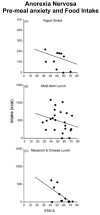The importance of eating behavior in eating disorders
- PMID: 21570418
- PMCID: PMC3139829
- DOI: 10.1016/j.physbeh.2011.05.007
The importance of eating behavior in eating disorders
Abstract
A disturbance in eating behavior is the defining characteristic of the clinical eating disorders, Anorexia Nervosa, Bulimia Nervosa, and Binge Eating Disorder. Surprisingly little research has been devoted to assessing objectively the nature of the eating disturbances in these disorders, to elucidating what factors contribute to the development and persistence of these disturbances, or to describing how they change with treatment. This review, which is based on a Mars lecture delivered at the 2010 meeting of the Society for the Study of Ingestive Behavior, reviews objective information about the nature of the disturbances of eating behavior in eating disorders. These data suggest that more detailed knowledge of eating behavior is an essential component of a full understanding of eating disorders and may provide a foundation for studies of pathophysiology and for the development of new treatment methods.
Copyright © 2011 Elsevier Inc. All rights reserved.
Figures







References
-
- American Psychiatric Association. Task Force on DSM-IV. Diagnostic and statistical manual of mental disorders : DSM-IV. 4. Washington, DC: American Psychiatric Association; 2000.
-
- Walsh BT, Hadigan CM, Kissileff HR, Lachaussee JL. Bulimia Nervosa: A Syndrome of Feast and Famine. In: Anderson GH, Kennedy SH, editors. The Biology of Feast and Famine: Relevance to Eating Disorders. San Diego: Academic Press, Inc; 1992. pp. 1–20.
-
- Wilson GT, Grilo CM, Vitousek KM. Psychological treatment of eating disorders. Am Psychol. 2007;62:199–216. - PubMed
-
- Kissileff H, Wentzlaff T, Guss J, Walsh B, Devlin M, Thornton J. A direct measure of satiety disturbance in patients with bulimia nervosa. Physiology & behavior. 1996;60:1077–85. - PubMed
-
- Devlin MJ, Walsh BT, Guss JL, Kissileff H, Liddle R, Petkova E. Postprandial cholecystokinin release and gastric emptying in patients with bulimia nervosa. American Journal of Clinical Nutrition. 1997;65:114. - PubMed
Publication types
MeSH terms
Grants and funding
LinkOut - more resources
Full Text Sources
Medical
Miscellaneous

